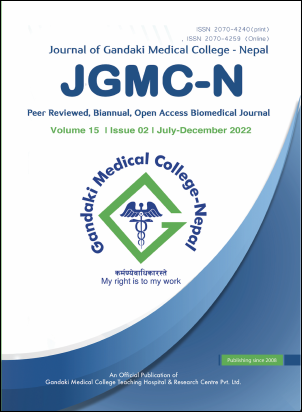Satisfaction with life among senior citizens in Pokhara metropolitan city: A cross-sectional study
DOI:
https://doi.org/10.3126/jgmcn.v15i2.48003Keywords:
Life satisfaction, Life satisfaction index, Role in family, Senior CitizensAbstract
Introduction: The number of senior citizens in the world is growing rapidly so life satisfaction is the best indicator for evaluating successful aging. The aim of the study was to assess life satisfaction among senior citizens in Pokhara metropolitan city.
Methods: This community-based cross-sectional study was conducted among 325 samples from 17 cluster of Pokhara metropolitan city. Life satisfaction were measured through life satisfaction index-A. Descriptive statistics and inferential statistics were computed at a 5% level of significance. Study participants were aged 60 years and above, residing permanently in the study sites. Wards, households, and respondents were selected randomly. Data were entered in Epi Data and analyzed using statistical package for the social sciences 16.0 version.
Results: Findings revealed that 53.5% respondents were not satisfied with their life. Likewise, age below 70 (52.4%), male respondents (53.7%), senior citizens (60+) living with partner (50.8%) were more satisfied. In multivariate analysis pension (OR=0.482, CI=0.248, 0.935), sufficient money for expenditure (OR=2.370, CI=1.362, 4.123), family income (OR=4.391, CI=2.019, 9.551), state of health (OR= 0.464, CI= 0.215, 0.923) and role in family decision making (OR=2.001, CI=1.055, 3.793) were positively associated with life satisfaction.
Conclusions: More than half of the senior citizens were dissatisfied with their life. Financial state, state of health and role in family decision making are the main determinant factors of life satisfaction. Therefore, the authority body needs to be developing proper old age policies to resolute the socioeconomic problems of old people.
Downloads
Downloads
Published
How to Cite
Issue
Section
License
Copyright (c) 2022 Ranjita Karmacharya, Nirupa Thapa

This work is licensed under a Creative Commons Attribution-NonCommercial 4.0 International License.
This license allows reusers to distribute, remix, adapt, and build upon the material in any medium or format for noncommercial purposes only, and only so long as attribution is given to the creator.




